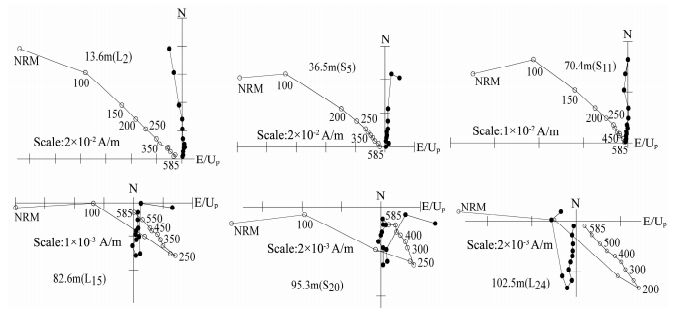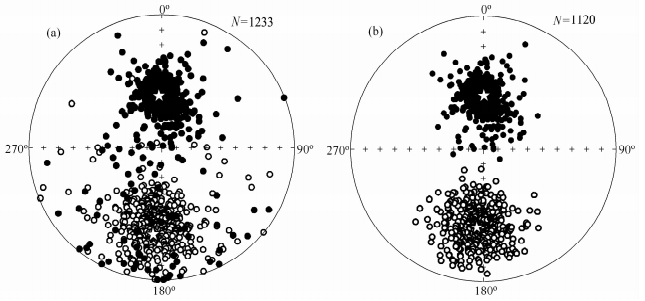中国具有全球厚度最大、连续性最好、时代最老的第四纪风成黄土,蕴含了丰富的古环境变化信息,与深海沉积和极地冰芯并称为古气候研究的三大支柱[1~4].作为中国黄土的标准剖面之一,洛川剖面自刘东生[5]首次报道以来,国内外研究人员对其进行了详细的研究[3, 6~15],取得了众多成果,是全球研究程度最深的黄土剖面之一.
洛川黄土的年龄框架主要是依据磁性地层建立,1982年HellerandLiu[6]首次突破技术瓶颈建立了比较可靠的磁极性地层.鉴于洛川剖面的重要性,后来,科学家对其磁性地层进行过多次研究[7, 8, 16~22],但由于采样间距过大,大多样品没有经过系统退磁,制约了磁性地层的精度和可靠性,对于磁极性界线的具体位置仍存在争议.为了更准确厘定磁极性界线的位置和建立可靠的磁极性地层,我们对洛川黄土进行了高密度的古地磁采样和测试,本文报道了这次古地磁研究的结果,主要解决洛川剖面中磁极性界线的具体位置.
2 样品的采集和实验方法 2.1 采样研究剖面位于黄土高原中部的洛川附近(图 1),该剖面发育完整的黄土-古土壤序列,下伏十几米厚的红粘土.本次研究从剖面顶部至红粘土上部60cm内,以10cm间隔采集水平定向古地磁标本,共获得1284块标本.每一个标本在室内加工成2cm×2cm×2cm立方体样品.

|
图 1 中国的黄土分布及洛川剖面地理位置,引自Sun and Zhu (2010)[23] Fig. 1 Sketch map showing loess distributions in China as well as the location of the Luochuan section[23] |
古地磁实验是在中国科学院地质与地球物理研究所古地磁学与地质年代学实验室完成的.所有样品用英国Magnetic Measurement公司生产的MMTD80型自动热退磁仪进行系统热退磁,在2G 760-R超导磁力仪上完成剩磁测量,实验过程均在零磁空间(<300nT)内进行.退磁温度以50℃间隔从100℃退至550℃,然后再加热至585℃,对于一些剩磁强度仍然较大的样品继续以25~10℃间隔退至680℃.
3 结果图 2为代表性样品的退磁结果.在表征退磁结果的剩磁矢量正交投影图上,所有样品包含两个剩磁分量,且大多数样品的剩磁第一分量,在200℃即可完全清洗,有些样品到300℃时才能完全清洗,此分量并不趋向于原点,为粘滞剩磁分量.剩磁第二分量在250℃或300℃后保持稳定,在正交投影图上趋于原点.剩磁强度在500~585℃时大部分已衰减,表明剩磁携带矿物主要为磁铁矿.选择稳定的250℃或300℃以上,趋近原点的至少3个温度点,一般4个以上温度点,利用主成份分析获得特征剩磁数据[24].有些样品粘滞剩磁很强,到200℃剩磁强度即衰减到90%以上,很难分离出特征剩磁方向,个别样品分离出的特征剩磁可信度较差(最大角偏差(MAD)大于15°),两者均予以剔除,共删除51个点,约占样品总数的4%.

|
图 2 代表样品的热退磁矢量图(N,E和Up分别为北、东和上方向,NRM为天然剩磁,数字代表退磁温度点,单位℃)实心圆和空心圆分别代表水平面和垂直面投影 Fig. 2 Orthogonal vector projections of typical specimens (N, E and Up represent north, east and up. NRM is natural remanent magnetization, number indicates the heating temperature). Solid (open) symbols represent the projections onto the horizontal (vertical) plane |
所有1233块有效样品的特征剩磁方向有一定的离散程度(DN=359.3°,IN=57.5°,KN=30.2,α95N=1.0°;DR=184.3°,IR=-35.6°,KR=8.0,α95R=2.3°,图 3a,其中DN(R),IN(R),KN(R),α95N(R)分别代表正(负)极性样品特征剩磁fisher平均的磁偏角,磁倾角,精度参数和95%的置信圆),其中1120块样品的特征剩磁记录了稳定的极性,113块样品的特征剩磁方向与平均方向离散度大于40°,可能记录了地磁场漂移或者极性转换过程[25].记录稳定极性的1120块样品的特征剩磁方向未能通过倒转检验,因为正负极性的倾角存在16.1°的差距(DN=359.6°,IN=57.1°,KN=49.4,α95N=0.8°;DR=184.4°,IR=-41.0°,KR=23.8,α95R=1.4°,图 3b),可能是近代场的黏滞剩磁并未完全清理干净[25].由样品特征剩磁获得的磁倾角和磁偏角计算出虚地磁极(VGP)纬度并依此得到剖面的磁极性序列.

|
图 3 所有有效样品(a)和去除与平均方向离散度大于40°样品后(b)的特征剩磁方向赤平投影图.星号代表各自极性的平均方向 Fig. 3 Equal area projections of the principal component directions: (a) 1233 samples that exhibit stable characteristic remanent magnetization (ChRM); (b) after excluding 113 samples that lay > 40° from the mean. White stars represent the mean directions in each polarity |
图 4给出了洛川剖面地层划分,所有有效样品的磁偏角、磁倾角和VGP纬度随深度变化结果,所有有效样品建立的磁极性柱1和去除与平均方向离散度大于40°样品后建立的极性柱2,以及它们与标准地磁极性年表的对比[26],其中地磁漂移Kamikatsura,Santa Rosa和Bjorn的年龄引自Roberts[27].SunandLiu[28]对洛川黄土剖面的地层进行过详细划分,本文沿用该文的地层划分方案.从图中可看出,极性柱1与极性柱2一致,表明利用所有有效样品建立的极性柱1的可靠性.松山-布容地磁极性倒转(即MB界线)位于S8的上部,Jaramillo极性亚时的顶、底界分别位于S10上部和L13的顶部,Olduvai极性亚时的顶、底界分别位于S25的顶部和L29的上部.并未出现GM(Gauss-Matuyama)界线,表明其至少位于黄土底界60cm以下.

|
图 4 洛川黄土地层划分、磁偏角、磁倾角和VGP (虚地磁极)纬度随深度变化,包含所有有效样品的极性柱1、去除部分与平均方向离散度大于40°样品后的极性柱2及与标准磁极性柱对比[26, 27] Fig. 4 Magnetostratigraphy of the Luochuan section. lithology, declination and inclination of the ChRM, virtual geomagnetic pole (VGP) latitude, magnetic polarity zonation 1, magnetic polarity zonation 2 and geomagnetic polarity timescale |
近年来,大量的高分辨率古地磁工作已经证明,黄土高原的不同地区均很好地记录了地磁极性转换过程和地磁漂移等转换场行为[29~34],表明黄土高原黄土的天然剩磁Lock-in深度很小,沉积后改造和成壤作用并不能造成大尺度的lock-in效应.另外,Liu等[35]发现黄土高原的灵台剖面和赵家川剖面的MB界线的岩石地层位置没有明显差异,也表明黄土中剩磁不存在显著的lock-in效应.
本次研究,洛川剖面各个磁极性地层的界线附近均出现了不同厚度包含多次快速倒转、VGP纬度异常(<45°)的极性转换过程,表明磁极性界线位置并不存在显著的Lock-in效应.MB界线的位置在53m,S8的上部(图 4),与最初HellerandLiu[6]的结果一致,而与安芷生等[21]及岳乐平[19]的结果相比MB界线位置偏低.最近Wang等[36]对三门峡黄土研究显示MB界线位于S8的上部,以及Liu等[35]将灵台和赵家川剖面用石英砂粒度作为地层划分标准,重新厘定的MB界线也位于S8的上部,而以前黄土高原发表的大多数剖面的MB界线位于L8中[31, 37~41],Liu等[35]认为MB界线不同剖面的记录差异是由地层划分方案不同所致.整个Brunhes期间洛川黄土厚53m,沉积速率6.8cm/kyr.
图 4显示L9自顶部至下部累计厚6.4 m的磁性正极性带(总厚度8.1m),L15顶部的1.2m以正极性为主,中间存在几块负极性样品,极性很不稳定.在以前的黄土高原古地磁研究中也多有发现L9中存在一定厚度正极性带[22, 40, 42~44],但该正极性带在国际标准地磁年表中未有记录[26, 45].有些研究L15全部为负极性样品[6, 39, 46],但在西峰[38]、蓝田[40]和灵台[41]剖面同样也发现了L15的上部存在正极性样品.Wang等[43]认为L9层的正极性带为重磁化带,而其他的研究者认为这是地磁漂移的记录[22, 40, 42, 44].L9持续时间可能为7.8万年[4],6.4m厚的正极性带累计达6万年,很难解释为地磁漂移,而L15的顶部1.2 m的正极性段,按沉积速率推算相当于0.4万年[4],可能是一次地磁漂移.L9中正极性带的性质及成因需要进一步研究,但已有的黄土剖面研究,MB界线位于L8或S8中[6, 19, 21, 31, 33, 35~37, 39~41],Jaramillo的上界位于L10或S10中[7, 8, 31, 32, 36, 38~40],L9中的正极性带并不影响所建立的极性柱与标准极性柱的对比.
Jaramillo的上界极性转换带较薄,位于67.6~67.9m,中间位置67.8 m,S10的上部,与Kukla和An(1989)[8]和Heller和Liu[7]结果一致,三门峡剖面[36]和蓝田剖面[40]的Jaramillo上界也位于S10中,而靖边[32]、渭南[31]、宝鸡[39]和西峰[38]等剖面显示Jaramillo的上界位于L10中.
Jaramillo的下界极性转换带,位于72.3~72.6m,厚0.3m,为L13的顶部.与Kula和An[8]的结果一致,而Heller和Liu[7]的结果显示Jaramillo的下界位于S11的底部.三门峡黄土Jaramillo的下界也位于L13的顶部[36],黄土高原多数剖面的Jaramillo的下界位于L12中[31, 32, 38, 39].本次研究,整个Jaramillo极性亚时的累计厚度4.7m,沉积速率5.9cm/kyr.由于L9和L15之间的几层黄土和古土壤层比较密集,不同作者对地层的划分差异,可能是Jaramillo的上下界线不同剖面记录差异的原因.
Olduvai的上界转换带位于106.9~107.4 m,中间位置107.2 m,S25的顶部,相当于以前划分的WS2的上部[28].Olduvai的下界转换带位于114.1~114.3 m,中间位置114.2 m,L29的上部,相当于WL2的上部[28].整个Olduvai极性亚时,累计厚7m,沉积速率3.9cm/a.与以前的结果相比[7, 8],Olduvai极性亚时的位置整体偏低,但是累计厚度均约7 m,较为一致.本次研究结果,与宝鸡[39]、灵台[47]和平凉[41]剖面相比,Olduvai极性亚时的位置也偏低.
本次研究,只测量到黄土底界以下60cm,并未检测出Matuyama的底界.较早的研究结果表明,洛川黄土Matuyama的低界位于红粘土内距黄土低界约2m处[7, 8].而最近,王先彦等[48]和杨石岭[49]研究表明,Matuyama位于洛川黄土的底部.可能是不同学者对于黄土底界的划分标准不同,造成洛川剖面Matuyama底界的位置不一致.
5 结论通过以上分析,初步得出如下结论:
洛川黄土剖面准确记录了2.6 Ma以来主要的地磁极性倒转.其中,MB界线位于53 m处,S8的上部;Jaramillo的上界位于67.8 m,S10的上部,下界位于72.5 m,L13的顶部;Olduvai的上界位于107.2m,S25的顶部,相当于WS2的上部,下界位于114.2m,L29的上部,相当于WL2的上部.并未出现GM界线,可能位于红粘土内,至少在黄土底界60cm以下.
致谢黄孝刚、靳春胜参加了野外工作,四位匿名审稿人提出了很多宝贵意见,作者在此表示感谢.
| [1] | 刘东生. 黄土与环境. 北京: 科学出版社, 1985 : 1 -412. Liu T S. Loess and Environment (in Chinese). Beijing: Science Press, 1985 : 1 -412. |
| [2] | An Z S. The history and variability of the East Asian paleomonsoon climate. Quaternary Science Reviews , 2000, 19: 171-187. DOI:10.1016/S0277-3791(99)00060-8 |
| [3] | Porter S C, An Z S. Correlation between climate events in the North Atlantic and China during the last glaciation. Nature , 1995, 375: 305-308. DOI:10.1038/375305a0 |
| [4] | Ding Z L, Derbyshire E, Yang S L, et al. Stacked 2.6-Ma grain size record from the Chinese loess based on five sections and correlation with the deep-sea delta 18O record. 6-Ma grain size record from the Chinese loess based on five sections and correlation with the deep-sea delta 18O record.Paleoceanography , 2002, 17(3): 1003. DOI:10.1029/2001PA000725 |
| [5] | 刘东生. 黄土的物质成分和结构. 北京: 科学出版社, 1966 : 75 -77. Liu T S. Composition and Texture of Loess (in Chinese). Beijing: Science Press, 1966 : 75 -77. |
| [6] | Heller F, Liu T S. Magnetostratigraphical dating of loess deposits in China. Nature , 1982, 300: 431-433. DOI:10.1038/300431a0 |
| [7] | Heller F, Liu T S. Magnetism of Chinese loess deposits. Geophysical Journal International , 1984, 77: 125-141. DOI:10.1111/j.1365-246X.1984.tb01928.x |
| [8] | Kukla G, An Z S. Loess stratigraphy in central China. Palaeogeogra phy, Palaeoclimatology, Palaeoecology , 1989, 72: 203-225. DOI:10.1016/0031-0182(89)90143-0 |
| [9] | An Z S, Porter S C. Millennial-scale climatic oscillations during the last interglaciation in central China. Geology , 1997, 25: 603-606. DOI:10.1130/0091-7613(1997)025<0603:MSCODT>2.3.CO;2 |
| [10] | 沈承德, 易惟熙, 刘东生. 高分辨10Be记录与黄土地层定年. 第四纪研究 , 1994(3): 203–213. Shen C D, Yi W X, Liu T S. 10 Be records in loess with high resolution and the dating of loess stratigraphy. Quaternary Sciences (in Chinese) , 1994(3): 203-213. |
| [11] | 鹿化煜, 安芷生. 洛川黄土粒度组成的古气候意义. 科学通报 , 1997, 42(1): 67–69. Lu H Y, An Z S. Paleoclimatic significance of grain size composite of loess deposit in Luochuan. Chinese Science Bulletin (in Chinese) , 1997, 42(1): 67-69. |
| [12] | 陈骏, 汪永进, 季峻峰, 等. 陕西洛川黄土剖面的Rb/Sr值及其气候地层学意义. 第四纪研究 , 1999(4): 350–356. Chen J, Wang Y J, Ji J F, et al. Rb/Sr variation and its climatic stratigraphical significance of loess-palesol profile from Luochuan, Shanxi province. Quaternary Sciences (in Chinese) , 1999(4): 350-356. |
| [13] | 吴乃琴, RousseauD D, 刘东生. 110 ka来洛川黄土地层中蜗牛化石记录与环境因子分析. 中国科学D辑:地球科学 , 1996, 39(5): 494–502. Wu N Q, Rousseau D D, Liu T S. Land mollusk records from the Luochuan loess sequence and their paleoenvironmental significance. Science in China Series D-Earth Sciences (in Chinese) , 1996, 39(5): 494-502. |
| [14] | 鹿化煜, StevensT, 弋双文, 等. 高密度光释光测年揭示的距今约15-10ka黄土高原侵蚀事件. 科学通报 , 2006, 51(18): 2253–2259. Lu H Y, Stevens T, Yi S W, et al. An erosional hiatus in Chinese loess sequences revealed by closely spaced optical dating. Chinese Science Bulletin (in Chinese) , 2006, 51(18): 2253-2259. DOI:10.1007/s11434-006-2097-x |
| [15] | 张虎才, 杨明生, 张文翔, 等. 洛川黄土剖面S4古土壤及相邻黄土层分子化石与植被变化. 中国科学D辑:地球科学 , 2008, 51(3): 321–330. Zhang H C, Yang M S, Zhang W X, et al. Molecular fossil and paleovegetation records of paleosol S4 and adjacent loess layers in the Luochuan loess section, NW China. Science in China Series D-Earth Sciences (in Chinese) , 2008, 51(3): 321-330. DOI:10.1007/s11430-008-0012-9 |
| [16] | Hus J J, Han J. The contribution of loess magnetism in China to the retrieval of past global changes-some problems. Physics of the Earth and Planetary Inieriors , 1992, 70: 154-168. DOI:10.1016/0031-9201(92)90178-X |
| [17] | 张宗祜. 中国黄土高原中几个剖面的岩性、地层分析. 海洋地质与第四纪地质 , 1983, 3(3): 1–15. Zhang Z H. Lithological and stratigraphical analysis on the loess profiles of the Loess Plateau in China. Marine Geology & Quaternary Geology (in Chinese) , 1983, 3(3): 1-15. |
| [18] | 刘东生, 安芷生. 洛川北韩寨黄土磁性地层学的初步研究. 地球化学 , 1984(2): 134–137. Liu T S, An Z S. A preliminary magnetostratigraphic study of the Beihanzhai loess section. Geochimica (in Chinese) , 1984(2): 134-137. |
| [19] | 岳乐平. 我国黄土古地磁学研究新进展. 地质论评 , 1985, 31(5): 453–460. Yue L P. New progress in the paleomagnet study of loess. Geological Review (in Chinese) , 1985, 31(5): 453-460. |
| [20] | 王俊达, 李华梅, 刘东生, 等. 洛川黄土磁性、时代和古气候记录. 矿物岩石地球化学通报 , 1987(4): 207–210. Wang J D, Li H M, Liu T S, et al. Age, palaeoclimate and magnetism of the Luochuan loess section. Bulletin of Mineralogy, Petrology and Geochemistry (in Chinese) , 1987(4): 207-210. |
| [21] | 安芷生, KuklaG, 刘东生. 洛川黄土地层学. 第四纪研究 , 1989(2): 155–168. An Z S, Kukla G, Liu T S. Loess stratigraphy in Luochuan of China. Quaternary Sciences (in Chinese) , 1989(2): 155-168. |
| [22] | 岳乐平, 薛祥煦. 中国黄土古地磁学. 北京: 地质出版社, 1996 : 1 -132. Yue L P, Xue X X. Paleomagnetismof Loessin China (in Chinese). Beijing: Geological Publishing House, 1996 : 1 -132. |
| [23] | Sun J M, Zhu X K. Temporal variations in Pb isotopes and trace element concentrations within Chinese eolian deposits during the past 8 Ma:Implications for provenance change. Earth and Planetary Science Letters , 2010, 290: 438-447. DOI:10.1016/j.epsl.2010.01.001 |
| [24] | Kirschvink J. The least-squares line and plane and the analysis of paleomagnetic data. Geophys.JR Astron.Soc , 1980, 62: 699-718. DOI:10.1111/gji.1980.62.issue-3 |
| [25] | Gilder S, Chen Y, Sen S. Oligo-Miocene magnetostratigraphy and rock magnetism of the Xishuigou section, Subei (Gansu Province, western China) and implications for shallow inclinations in central Asia.. Journal of Geophysical Research , 2001, 106: 30505-30521. DOI:10.1029/2001JB000325 |
| [26] | Cande S C, Kent D V. Revised calibration of the geomagnetic polarity timescale for the Late Cretaceous and Cenozoic. Journal of Geophysical Research , 1995, 100: 6093-6095. DOI:10.1029/94JB03098 |
| [27] | Roberts A P. Geomagnetic excursions:Knowns and unknowns. Geophysical Research Letters , 2008, 35: L17307. DOI:10.1029/2008GL034719 |
| [28] | Sun J M, Liu T S. Stratigraphic evidence for the uplift of the Tibetan Plateau between similar to 1. 1 and similar to 0.9 myr ago.Quaternary Research , 2000, 54: 309-320. |
| [29] | Zhu R X, Laj C, Mazaud A. The Matuyama-Brunhes and upper Jaramillo transitions recorded in a loess section at Weinan, north-central China. Earth and Planetary Science Letters , 1994, 125: 143-158. DOI:10.1016/0012-821X(94)90212-7 |
| [30] | Zhu R X, Pan Y X, Liu Q S. Geomagnetic excursions recorded in Chinese loess in the last 70, 000 years. Geophysical Research Letters , 1999, 26: 56-58. |
| [31] | Pan Y X, Zhu R X, Liu Q S, et al. Geomagnetic episodes of the last 1.2 Myr recorded in Chinese loess. Geophysical Research Letters , 2002, 29(8). DOI:10.1029/2001GL014024 |
| [32] | Guo B, Zhu R X, Florindo F, et al. A short, reverse polarity interval within the Jaramillo subchron; Evidence from the Jingbian section, northem Chinese Loess Plateau. Journal of Geophysical Research , 2002, 107: B6. DOI:10.1029/2001JB000706 |
| [33] | Yang T S, Hyodo M, Yang Z Y, et al. Two geomagnetic excursions during the Brunhes chron recorded in Chinese loess-palaeosol sediments. Geophysical Journal International , 2007, 171: 104-114. DOI:10.1111/gji.2007.171.issue-1 |
| [34] | Yang T S, Hyodo M, Yang Z Y, et al. Latest Olduvai shortlived reversal episodes recorded in Chinese loess. Journal of Geophysical Research , 2008, 113: B05103. DOI:10.1029/2007JB005264 |
| [35] | Liu Q S, Roberts A P, Rohling E J, et al. Post-depositional remanent magnetization lock-in and the location of the Matuyama-Brunhes geomagnetic reversal boundary in marine and Chinese loess sequences. Earth and Planetary Science Letters , 2008, 275: 102-110. DOI:10.1016/j.epsl.2008.08.004 |
| [36] | Wang X S, Yang Z Y, Lovlie R, et al. A magnetostratigraphic reassessment of correlation between Chinese loess and marine oxygen isotope records over the last 1.1 Ma. Physics of the Earth and Planetary Interiors , 2006, 159: 109-117. DOI:10.1016/j.pepi.2006.07.002 |
| [37] | 朱日祥, 潘永信, 郭斌, 等. 海陆气候化记录相滞后:松山-布容极性转换约束. 科学通报 , 1998, 43(19): 1593–1598. Zhu Z X, Pan Y X, Guo B, et al. A recording phase lag between ocean and continent climate changes:constrained by the Matuyama/Brunhes polarity boundary. Chinese Science Bulletin (in Chinese) , 1998, 43(19): 1593-1598. DOI:10.1007/BF02883400 |
| [38] | Liu X M, Liu T S, Xu T C, et al. The Chinese loess in Xifeng, I:The primary study on magnetostratigraphy of a loess profile in Xifeng area, Gansu province. Geophysical Journal International , 1988, 92: 345-348. DOI:10.1111/j.1365-246X.1988.tb01146.x |
| [39] | Rutter N, Ding Z L, Evans M E, et al. Magnetostratigraphy of the Baoji loess-paleosol section in the north-central China Loess Plateau. Quaternary International , 1990, 7-8: 97-102. DOI:10.1016/1040-6182(90)90043-4 |
| [40] | Zheng H B, An Z S, Shaw J. New contributions to Chinese Plio-Pleistocene magnetostratigraphy. Physics of the Earth and Planetary Interiors , 1992, 70: 146-153. DOI:10.1016/0031-9201(92)90177-W |
| [41] | Sun D H, Shaw J, An Z S, et al. Magnetostratigraphy and paleoclimatic interpretation of a continuous 7. 2 Ma Late Cenozoic eolian sediments from the Chinese Loess Plateau.Geophysical Research Letters , 1998, 25: 85-88. |
| [42] | Xiong S F, Ding Z L, Liu T S. Climatic implications of loess deposits from the Beijing region. Journal of Quaternary Science , 2001, 16: 575-582. DOI:10.1002/(ISSN)1099-1417 |
| [43] | Wang X S, Lovlie R, Yang Z Y, et al. Remagnetization of Quaternary eolian deposits:A case study from SE Chinese Loess Plateau. Geochemistry Geophysics Geosystems , 2005, 6: Q06H18. DOI:10.1029/2004GC000901 |
| [44] | Zheng H B, Huang X T, Ji J L, et al. Ultra-high rates of loess sedimentation at Zhengzhou since Stage 7:Implication for the Yellow River erosion of the Sanmen Gorge. Gemnorphology , 2007, 85: 131-142. DOI:10.1016/j.geomorph.2006.03.014 |
| [45] | Ogg J, Smith A G, The geomagnetic polarity time scale.In:Gradstein F M, Ogg J G, Smith A G, eds.A Geological Time Scale.Cambridge.Cambridge University Press, Cambridge, 2004.63~86 |
| [46] | Yang T S, Hyodo M, Yang Z Y, et al. Early and middle Matuyama geomagnetic excursions recorded in the Chinese loess-paleosol sediments. Earth, Planets, and Space , 2007, 59: 825-840. DOI:10.1186/BF03352745 |
| [47] | Ding Z L, Sun J M, Yang S L, et al. Preliminary magnetostratigraphy of a thick eolian red clay-loess sequence at Lingtai, the Chinese Loess Plateau. Geophysical Research Letters , 1998, 25: 1225-1228. DOI:10.1029/98GL00836 |
| [48] | 王先彦, 鹿化煜, 弋双文, 等. 晚新生代洛川典型风尘堆积序列的延伸. 海洋地质与第四纪地质 , 2006, 26(1): 89–92. Wang X Y, Lu H Y, Yi S W, et al. Extension of the typical aeolian sequences at Luochuan, central Chinese Loess Plateau. Marine Ceology & Quaternary Geology (in Chinese) , 2006, 26(1): 89-92. |
| [49] | 杨石岭, 晚中新世以来中国北方风成沉积的磁性地层学和沉积学研究[博士论文].北京:中国科学院研究生院, 2001 Yang S L.Magnetostratigraphy and sedimentology of the eolian deposits in northern China since the late Miocene[Ph.D.thesis](in Chinese).Beijing:Graduate University of Chinese Academy of Sciences, 2001 http://mall.cnki.net/magazine/article/ZKYB200202018.htm |
 2010, Vol. 53
2010, Vol. 53


